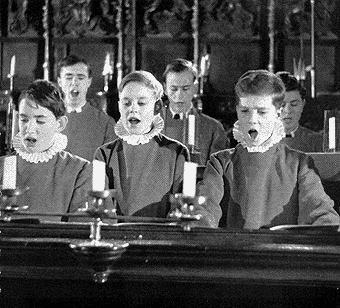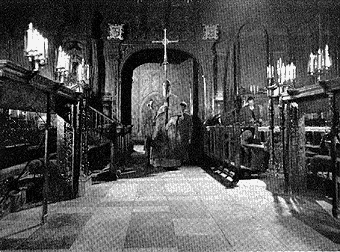A still from the 1960 BTF Catalogue.

|
A.L. Rowse, the eminent historian has written, 'The Elizabethan Age is not something dead and apart from us... Wherever one goes in England there are visible memorials of what thise men and women were when they were alive, the houses they built and loved and lived in, the things they made and wore, the objects they cherished, the patterns they imposed upon the very landscapes.' Some of the visible traces as well as something of the spirit of that England of Elizabeth, of Drake and Raleigh and of Shakespeare, are recorded in this film.
'Such stuff as dreams are made of, outlasting the years'. The camera conjures up Tudor England. A memorable commentary by John Moore is spoken by Alec Clunes, and a magnificent musical score by Ralph Vaughan-Williams helps to create a film which looks back in wonder at the unique era of Shakespeare and the first Elizabeth.
Winner of three international film awards.
Additional Notes courtesy of Richard Worswick: This film was brielfy released on video by F.A.M.E. in 1995, described as "the award winning documentary film recalling the first Elizabethan age through surviving artefacts. The music is by Ralph Vaughan Williams, played by the Sinfonia of London, conductor John Hollingswsorth." The video also included a previously unpublished sequence of the recording session with the composer alongside the conductor. Although this video is no longer available and has not been released subsequently, a clip of the sequence featuring Ralph Vaughan Williams at the recording session is now on google video for all to enjoy coutesy of Barry Coward at Beulah :-
The late David Watkin - Oscar-winning Cinematographer - reminisced about his time filming The England of Elizabeth. www.davidwatkin.co.uk
“Edgar promised Ritchie, who was getting restless, a break to direct and so I took over The England of Elizabeth with John Taylor again. It is nice to have one’s name on the same picture as Vaughan Williams although on the only occasion when I should have met the great man I was sent off to get a shot of a train at Woking. Par for the course (I don’t play golf but learned this expression from my electricians who all do), but VW was one of my heroes. It is part of the price one pays for going up in the world; if I’d still been chauffeuring people to music recordings I’d have seen him. It appears to have been quite a session as at one point the old man, who was no lightweight, tipped too far back in his chair and was only saved from disaster by Edgar making a dive and grabbing him.
Somebody that I did meet on the film was the founding father of documentary himself. John Grierson was married to John Taylor’s sister and we drove down to their farm, Tog Hill in Wiltshire, to shoot a fiery beacon for the Spanish Armada. I remember sitting in a very spacious room, a converted barn I think, with a staircase at one end at the top of which was a door. Grierson came in through this door talking, descended the stairs talking, shook hands, sat down opposite and continued talking for about an hour and a half then retired up the stairs talking and disappeared through the door.
My first ever lit interior turned out quietly enough to be the nave of King’s College Chapel in Cambridge. There was a fair sprinkling of deans, proctors etc but their attention was soon diverted away from me by the sight of Arthur Green and Fat Mac (Donald) of Mole Richardson proceeding down the aisle arm in arm as bride and groom, Arthur making a very camp bride as I remember.
Another aspect of John was that of the naturalist and I remember one halcyon day during The England of Elizabeth, on a remote sea shore on the west coast, John, in no hurry about shooting, wandering at low tide and looking into rock pools, described a traditional way to catch lobsters by poking a stick into their lairs; because lobsters combine stupidity with stubbornness, they never let go once they have laid hold, and are pulled out of the water supplying their own hook as it were. It is called diddling, with the first “i” pronounced long.”

